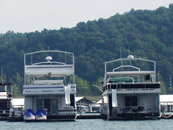The connection between a land-based source of electricity and your boat is called shorepower.
The concept of shorepower is kinda cool, in that it allows you to operate 110-volt household-type appliances (TV, refrigerator, microwave oven, etc) on your boat while your boat’s tied up to the dock, without needing to use an on-board generator or to deplete your boat’s batteries—in fact, you can recharge the batteries with shorepower.
There’s more to shorepower than just running an extension cord from your boat to a plug-in on the dock. Your boat’s electrical system is designed for the 12-volt power supplied by the batteries; it won’t handle higher voltage. So, in order to safely use shorepower, your boat needs to have a second electrical system
(including larger wiring, different outlets and switches, and increased circuit protection) for the more potent 110-volt current.
Most boats that use 110-volt electrical devices come from the factory completely set up for shorepower. Although you can retrofit an older or smaller boat for shorepower, we wouldn’t recommend it, unless you’re an experienced electrician.
Components
The parts of a basic shorepower system are:
- A special, heavy-duty extension cord to connect the land-based source of electricity to the boat
- A connector on the outside of the boat to accept the shorepower electrical cord
- A transformer on the inside of the boat to receive the electricity from the power source on land. If the electrical current from the shore isn’t quite as high as the boat’s system needs it to be, the transformer can slightly increase the electricity from land to meet the on-board electrical system’s minimum requirements
- For safety, the transformer also isolates the electricity coming into the boat from the boat’s electrical system; power from the shore must pass through the transformer to get to the boat
- The boat’s internal 110-volt electrical system, made up of wires, switches, receptacles and circuit breakers.
